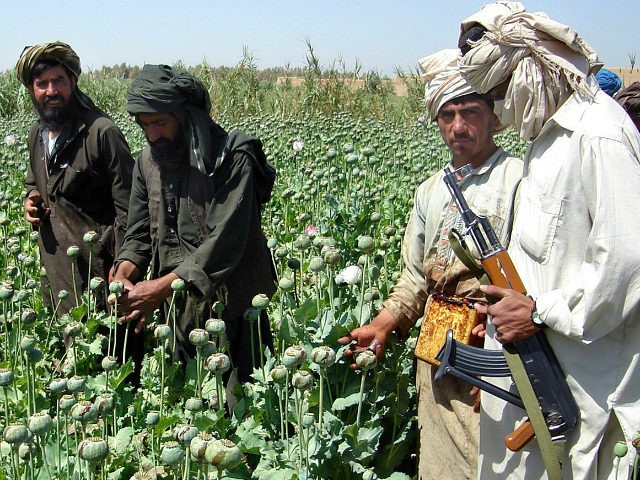The U.S. is spending hundreds of millions of dollars on agricultural projects in Afghanistan, including irrigation canals linked to opium and heroin production.
Drugs from Afghanistan have been implicated in three-quarters of fatal heroin overdoses worldwide, including deaths from the opioid crisis gripping the United States.
John Sopko, U.S. Special Inspector General for Afghanistan Reconstruction (SIGAR) watchdog agency established by Congress, wrote about Afghan opium production in his quarterly report issued on Tuesday.
Despite spending about $9 billion on counternarcotics efforts in Afghanistan since the war started nearly 17 years ago, Afghanistan remains the globe’s tops supplier of opium and its heroin derivative. Opium is Afghanistan’s largest cash crop.
Eradicating opium-poppy cultivation and drug production has been an important mission, although not the primary goal of the United States and its partners in Afghanistan. The drug trade is putting reconstruction and national security at risk by financing Taliban jihadi groups and feeding government corruption.
SIGAR’s analysis revealed:
No counternarcotics program led to lasting reductions in poppy cultivation or opium production. Eradication efforts had no lasting impact, and eradication was not consistently conducted in the same geographic locations as development assistance. Alternative-development programs were often too short-term, failed to provide sustainable alternatives to poppy, and sometimes even contributed to poppy production. Sustained reductions in Afghan poppy cultivation and drug production will ultimately require improved security, governance, and economic growth.
SIGAR reports former President Barack Obama’s administration, which ended U.S.-led eradication efforts at a time when the production of opium and heroin production was hitting record levels, extended the failed Kandahar Food Zone (KFZ) and the Strengthening Watershed and Irrigation Management (SWIM) programs. These initiatives funded the construction of irrigation canals and provided fertilizer for a few years beyond 2016, at a cost of more than $133 million to American taxpayers.
The KFZ tries to push farmers away from poppy cultivation in Kandahar Province, the birthplace of the Taliban, by “rehabilitating irrigation infrastructure, expanding alternative-livelihood opportunities, supporting small businesses, and building the capacity of the [Ministry of Counter Narcotics] to develop effective alternative-development policies,” as Sopko wrote.
In other words, even though SIGAR has found that some of the irrigation canals have been used to cultivate deadly opium, the U.S. Agency for International Development (USAID) is intent on supporting “activities that include rehabilitating irrigation infrastructure.”
Natural opium and heroin produced largely in Afghanistan and the synthetic fentanyl that mainly originates in China are responsible for the vast majority the unprecedented 63,632 fatal drug overdoses in the U.S., based on the most recent available data.
“According to the latest World Drug Report, opioids continue to cause the most harm, accounting for 76 percent of drug-related deaths worldwide,” SIGAR noted.
SIGAR noted that the farmers’ financial incentives to cultivate opium may still take precedence over their need to grow food, further exacerbating food shortages.
Sopko noted:
The World Bank’s characterization that agriculture is a pillar of national security requires a major caveat—SIGAR has reported that opium-poppy cultivation has undermined security goals by providing a major revenue source for the insurgency, undermining Afghan government legitimacy, and exacting an enormous human and financial toll.
As SIGAR reported last quarter, seasonal precipitation and snowpack deficits have resulted in a drought affecting large swaths of Afghanistan. According to the United Nations, two-thirds of provinces have been affected. Consequently, the UN anticipated that two million Afghans would become “severely food insecure” and “in desperate need of life-saving humanitarian assistance” within the next six months, as of June 2018.
SIGAR noted the U.S. Agency for International Development (USAID), charged with agriculture efforts in Afghanistan, has “disbursed nearly $2.2 billion to improve agricultural production, increase access to markets, and develop income alternatives to growing poppy for opium production.”
There is some reason for optimism on that front, because even though Afghanistan still grapples with food shortages, “USAID anticipated that the harvest for high-value irrigated crops would be productive.”
Last month, SIGAR revealed opium and heroin production in Afghanistan have benefited greatly from $2.2 billion in U.S. taxpayer funding for agricultural programs and tools. On the other hand, SIGAR’s analysis found “no counternarcotics program led to lasting reductions in poppy cultivation or opium production,” and “eradication efforts had no lasting impact.”

COMMENTS
Please let us know if you're having issues with commenting.